UPDATE: Sad news – our hero rat Chiku passed away in November from a large invasive tumor. We will miss her.
Turns out, when you give physicals to giant pouched rats, some things are easy – like examining their long curved front teeth.
Getting a blood sample from those tiny veins? Not so easy. But it’s a vital part of assessing health.
“I’ll try the jugular first,” says head veterinarian Dr. Karen Wolf, gently parting soft white fur on Mona Lisa, first in the rat exam line-up.
Ambassador Hero Rats
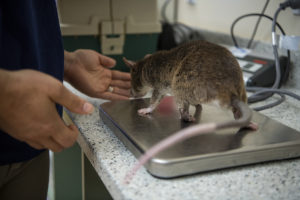
Celine, Chiku and Mona Lisa are three African giant pouched rats who’ve recently arrived at Point Defiance Zoo & Aquarium. Native to southern Africa, pouched rats are a different species from domestic rats – longer (up to 12 inches in body and another 12 for the tail), longer-lived and with adorable cheek pouches that they use to store food, like a hamster.
They also have incredible noses, with 1,000 genes for scent detection – more even than a dog. Because of that skill, plus general smarts, trainability and friendliness, pouched rats are trained in Tanzania to detect landmines and tuberculosis, saving countless lives.
Celine, Chiku and Mona are graduates of that training, but not 100 per cent reliable. And so they’ve become ambassadors for these heroic rats – the first ever to come to live in a North American zoo.
Eyes, ears, teeth, bones
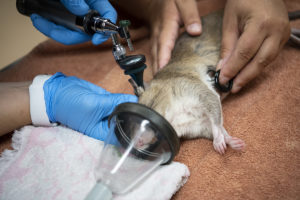
First, though, they need check-ups.
“Come on, girl.”
Staff biologist Jessie Sutherland gently lifts Mona out of her travel crate – hand-made by her Tanzanian trainers from repurposed large water containers ¬– and onto a soft towel on the exam table. Wolf, intern veterinarian Dr. Kat Reed and veterinary technician Julie Lemon work smoothly to take a rectal sample, X-rays and ultrasound images. Mona’s bright eyes and huge, delicate ears are examined, as well as her tiny pink paws. A fast heartbeat – typical for small mammals – beats constantly on the monitor.
Wolf looks closely at Mona’s teeth; like all rodents she has two long incisors that grow constantly throughout her life. Tinged orange from the iron that makes them so strong, the teeth need to be perfectly aligned, or they’ll need filing by vets to avoid puncturing lips or gums.
“These are great,” pronounces Wolf, double-checking with the radiograph. “Really good alignment and condition.”
Those blood samples
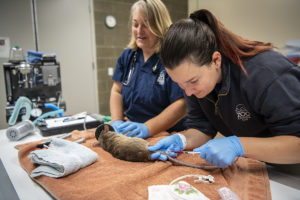
The one thing that’s challenging in a rat exam is drawing a blood sample from those tiny limbs. Wolf gets a small amount from the jugular, but then has better luck with a vein in Mona’s small furry leg.
Celine and Chiku are the same size – all three rats look remarkably similar – and are just as tricky to sample.
Eventually, Reed triumphs with an impressive 0.4 ml from Celine’s lateral tail vein. All of the rats will get a complete blood count to confirm their good health before they can join other animals at the zoo’s Wild Wonders Outdoor Theater.
The team also looks closely at a small mass protruding from Chiku’s belly that Sutherland has noticed as she cares for the rat daily.
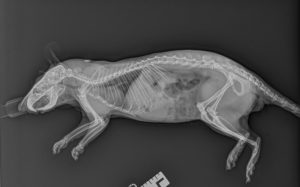
The team needs to determine if it’s a hernia – where abdominal organs protrude through the body wall – or a tumor. They give her a barium solution, which will highlight the intestinal tract, showing on later X-rays whether the mass is a hernia or not.
(The mass turns out to be a hernia, and the team safely removes it from Chiku during a later procedure.)
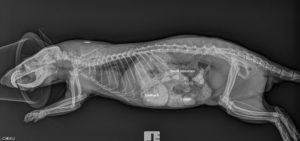
“That’s why we do these exams,” says Wolf. “To find out things you never would otherwise, and prevent problems from going undetected. It’s all part of giving our best care to every animal here.”
LEARN MORE: You can read more about our new pouched rats and their training here.
SEE THEM: Celine, Chiku and Mona Lisa will be making their debut July 20-21, demonstrating their detection abilities at Close Encounters 2pm each day near the picnic pavilion. A trainer from non-profit APOPO will give a presentation on the rats at 6pm Thursday July 18 in the Education Center. The rats will continue to give demonstrations through the summer.